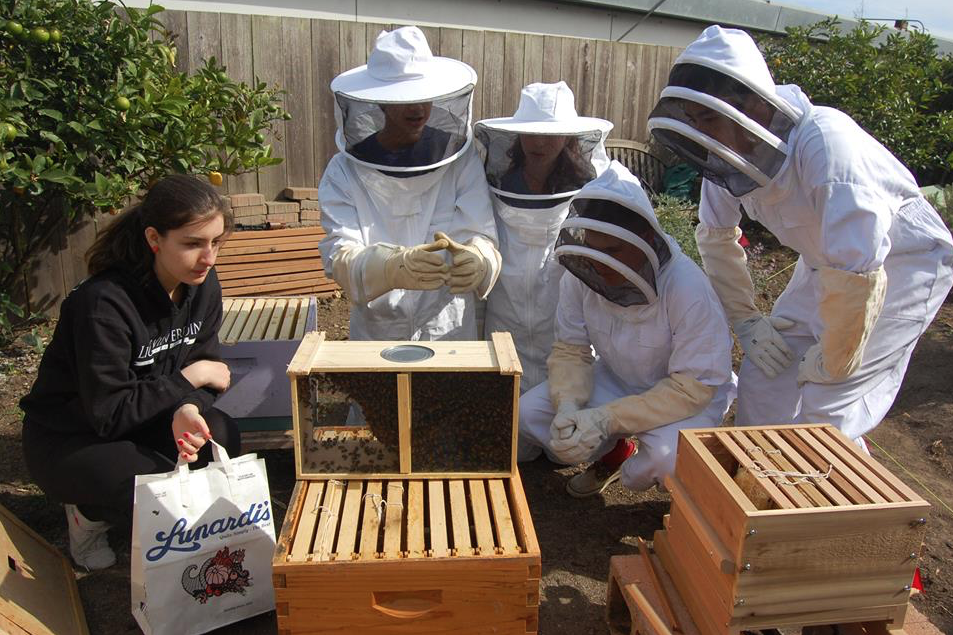Tragedy struck the Lick- Wilmerding community this past summer as the bee colonies living in the garden were destroyed by an unknown menace. In fact, colonies of honeybees are collapsing in alarming numbers throughout the agricultural world.
Nikhil Brocchini ‘16 brought the bees to Lick- Wilmerding in the spring of his sophomore year. The Beekeeping Club raised money to bring the hives and bees to our community. After raising about 650 dollars they had enough money to build the bees a home in the left wing of Lick’s garden. Not only has the club brought bees into our garden, but they have also planned garden workdays to create a better habitat for the bees and humans.
Brocchini and the faculty leader Anton Krukowski both have their own beehives at home, which have done magnificently well. So what happened to our bees? There is no clear answer.
Brocchini brought three hives to Lick; none survives.

Krukowski explained how after one of Lick’s bee hives fell over, the bees wouldn’t return to the hive even after it was righted. The club used the help of the San Francisco Beekeeping Association to recapture the bees and relocate them. Krukowski said,“We couldn’t put them right back into the hive here, because it seemed that hive was damaged in some way when it tipped over, which is why they left.” Those bees now reside in hives in an empty lot on Bernal Heights with many flowers and other plants for the bees to feed from.
The cause of death in Lick’s other two colonized hives is unknown. Both Brocchini and Krukowski believe that the Deformed Wing Virus (DWV) may have caused the deaths of the other two hives. Krukowski remembers “several bees walking on the ground in the garden with badly formed wings. It’s possible that the virus spread too much, and made the hive inefficient.”
As leader of Beekeeping Club and a graduating senior, Brocchini is focused on the future of beekeeping at Lick. He hopes that the club “will replace the bees, either by capturing a swarm or by purchasing a package.” The bees may continue to bless Lick’s garden but this does not mean that this community can stop worrying about the fate of its bees. Brocchini said that “although the phenomenon known as Colony Collapse Disorder (CCD) has been occurring less and less over the last few years, overall hive mortality — whether or not it’s related to CCD — has been getting higher and higher.” Colony Collapse Disorder is defined by the United States Environmental Protection Agency as a “phenomenon that occurs when the majority of worker bees in a colony disappear and leave behind a queen, plenty of food and a few nurse bees to care for the remaining immature bees and the queen.” The frequency of CCD has decreased. But the bee population is still in decline.
In Bernal Heights, Krukowski and his son raise bees together and make gallons of honey. One of their hives survived through the winter while one did not.

Krukowski believes that the death may have been from a misapplication of a treatment that beekeeper use to protect bees from mites. He looks forward to replacing his hive in the spring.
In an interview with The Paper Tiger, Dr. Hannah Gaines Day, an entomologist at the University of Wisconsin, Madison, discussed her research on the fragmentation of the habitats of wild bees. Although she focuses on wild bees she spoke about the possible factors of the decline of Honey Bees: “poor nutrition (loss of flowers across the landscape), pesticide exposure, parasites (in particular, Varroa mites), and disease.” Dr. Gaines Day stated that these factors are like a “perfect storm,” because they are all occurring at the same time and have drastic impacts on the honey bees. Dr. Gaines Day gave the example of “parasites and disease compounded by the poor nutrition and pesticides harming the bees’ immune system so they aren’t able to fight off the attacks as well.” Right now, Dr. Gaines-Day is researching whether cranberries need bees and working on the impact of wild bees. While honey bees are seeing an overall increase in population because of humans breeding new bee colonies, wild bees are still declining.
One of the main reasons that wild bees are facing a decline in population according to Dr. Gaines Day is that “recent research shows that wild bees are in trouble due to habitat loss (resulting in loss of food and nesting sites) and pesticide exposure.” Dr. Gaines Day says that unlike honey bees, wild bees do not have a hive or a queen so they are harder to study. Wild bees do not produce honey but play a vital role in the agricultural ecosystem. Most
of habitat loss comes from crops being planted that destroy bee’s nesting land. The plants that are being planted by farmers are not high in nutrition, and farmer’s use harmful chemicals.
Claire Kremen in NPR’s piece “Wild Bees Are Good For Crops, Crops Are Bad For Bees” points out that “where we have very large monocultures of almonds, we don’t find any native bees anymore.”
Bees and pollinators are essential to food production. And food is essential to sustaining life. Raising food is also an important pillar of the American economy. The White House has turned its attention to the bee problem.
President Obama issued a memorandum, “Creating a Federal Strategy to Promote the Health of Honey Bees and Other Pollinators,” to create a task force to combat the loss of pollinators. This task force released their strategy, the “National Strategy to Promote the Health of Honey Bees and Other Pollinators.” John P Holdren wrote in his article for whitehouse.gov “the main goals of the task force are to reduce honey bee colony losses to economically sustainable levels…and to restore or enhance millions of acres of land for pollinators through combined public and private action.” The task force claims they will “restore or enhance seven million acres of land for pollinators over the next five years through Federal actions and public/private partnerships.”
In both the memorandum and the task force report the economic impact of honey bees was highlighted; it is estimated that these essential pollinators add around 15 billion dollars to the agricultural economy. Billions of dollars have been granted to researchers to try to better understand what is happening to the pollinator, specifically the bees, and what humans can do to lessen the impact.
What can we do? Brocchini suggests that “people should come to Beekeeping Club at lunch on Day 4 in the Biochem room.”
Dr. Gaines Day encourages people to “to plant flowers, lots and lots of flowers of all different colors and shapes and varieties so that there is continuous flowering throughout the growing season.” Our community has done this in our garden, but it can be easily implemented in the many homes of our community. Kremen also mentioned in the NPR piece that “planting other flowers in and around these almond groves, maybe as hedgerows, blooming all summer long, would help.” This is a way that researchers and farmers are trying to help the bees.
Dr. Gaines Day also specially advised, “reduce overall pesticide use and when pesticides are needed, apply them according to the label which means NOT using them when flowers are in bloom.” These small things can help stop future deaths of our community’s bees and the global bee community. Krukowski also urges that we plant more flowers, as well as advocate “for legislation to ban pesticides that have been shown to be harmful to bees, like neonicotinoids. The EU banned these pesticides a couple of years ago, and we have not.”
Not everyone can raise honeybees or devote their life to researching their hive health, but planting and supporting local gardens can make a positive impact on the lives of bees and other pollinators. We can make support bees and a bountiful harvest of California fresh produce; we can empower a healthy agricultural system possible.







